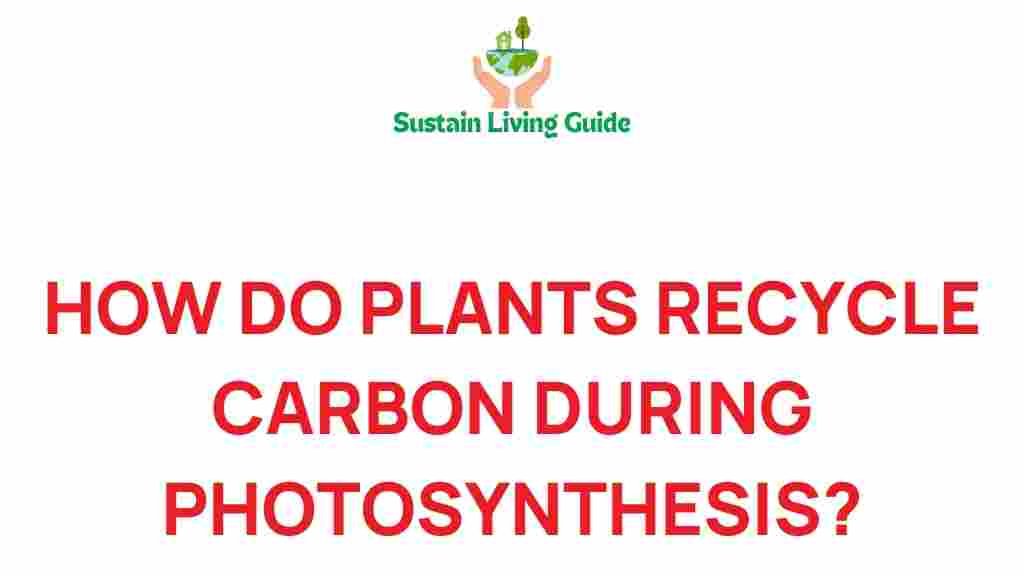Unveiling the Secrets: How Plants Master Carbon Recycling
In an era of increasing environmental awareness, understanding the intricacies of carbon recycling has never been more vital. Plants play a crucial role in this process, acting as natural recyclers of carbon dioxide (CO2) through photosynthesis. This article will delve into how plants master carbon recycling, the benefits it offers to our ecosystem, and the steps we can take to support this vital process.
The Importance of Carbon Recycling
Carbon recycling is the process through which carbon is reused and repurposed within ecosystems. It is fundamental for maintaining the balance of atmospheric gases and ensuring life on Earth. Here are some key reasons why carbon recycling is critical:
- Climate Regulation: Plants absorb CO2, a greenhouse gas, helping to reduce the impact of climate change.
- Soil Health: Through carbon recycling, plants contribute to soil organic matter, enhancing soil fertility.
- Biodiversity Support: Healthy ecosystems foster diverse plant and animal life, which relies on efficient carbon recycling.
The Process of Carbon Recycling in Plants
Plants utilize a fascinating process to recycle carbon effectively. This process primarily occurs through photosynthesis, respiration, and decomposition. Understanding each step can illuminate how plants contribute to carbon recycling.
1. Photosynthesis: The Beginning of Carbon Recycling
Photosynthesis is the cornerstone of carbon recycling in plants. This process occurs in the chloroplasts of plant cells and can be broken down into several key stages:
- Light Absorption: Chlorophyll, the green pigment in plants, absorbs sunlight.
- Water Splitting: Light energy splits water molecules into oxygen and hydrogen.
- Carbon Dioxide Uptake: Plants absorb CO2 from the atmosphere through tiny openings called stomata.
- Sugar Production: The absorbed CO2 and hydrogen combine to form glucose, a simple sugar that serves as energy for the plant.
This process not only provides energy for the plant but also releases oxygen, which is essential for the survival of most life forms on Earth.
2. Respiration: The Cycle Continues
While photosynthesis is critical for energy production, plants also undergo respiration, which plays a vital role in carbon recycling:
- Energy Release: During respiration, plants break down glucose to release energy for growth and development.
- CO2 Release: As a byproduct of this process, plants release CO2 back into the atmosphere.
This may seem counterintuitive, but respiration is essential for maintaining the balance of carbon within ecosystems.
3. Decomposition: The Final Act
When plants die or shed leaves, they contribute organic matter to the soil. Decomposition is the process through which microorganisms break down this organic material:
- Microbial Action: Decomposers, such as bacteria and fungi, play a significant role in breaking down dead plant matter.
- Carbon Release: As this organic matter decomposes, carbon is released back into the soil and atmosphere, enriching soil health.
In this way, carbon is cycled repeatedly through the ecosystem, showcasing the efficiency of nature’s recycling system.
Understanding Carbon Cycling and Its Benefits
Carbon cycling is essential for various reasons, and its benefits extend beyond just the immediate ecosystem. Here are some of the broader advantages of carbon recycling:
- Mitigating Climate Change: By capturing CO2, plants help lower the concentration of greenhouse gases in the atmosphere.
- Boosting Agriculture: Healthy soil, rich in organic carbon, leads to increased agricultural productivity.
- Improving Air Quality: As plants absorb CO2, they also filter pollutants from the air.
How to Support Carbon Recycling in Your Environment
Supporting carbon recycling can be a simple yet impactful endeavor. Here are some effective steps you can take:
- Plant Trees: Trees are significant carbon sinks and can absorb large amounts of CO2 from the atmosphere.
- Promote Native Flora: Native plants are adapted to local conditions and support local ecosystems, enhancing carbon recycling.
- Practice Sustainable Gardening: Composting organic waste can enrich soil and improve its carbon content.
- Reduce Waste: By minimizing waste, you can reduce the carbon footprint associated with disposal and decomposition.
For more detailed information on sustainable practices, you can visit this resource.
Troubleshooting Common Issues in Carbon Recycling
While carbon recycling is a natural process, several factors can hinder its efficiency. Here are some common issues and troubleshooting tips:
1. Soil Degradation
Problem: Over-farming, deforestation, and pollution can lead to nutrient-poor soils that hinder carbon storage.
Solution: Practice crop rotation, use organic fertilizers, and reduce chemical usage to enhance soil health.
2. Climate Change Effects
Problem: Climate change can alter weather patterns, affecting plant growth and photosynthesis rates.
Solution: Support local conservation efforts and engage in community programs aimed at restoring ecosystems.
3. Invasive Species
Problem: Invasive plants can outcompete native flora, disrupting local ecosystems and carbon recycling processes.
Solution: Educate yourself about local invasive species and participate in removal programs.
Conclusion: The Future of Carbon Recycling
As we face increasing environmental challenges, understanding and supporting carbon recycling has never been more critical. Plants, through their intricate processes of photosynthesis, respiration, and decomposition, play a vital role in maintaining the balance of our ecosystem. By taking proactive steps to support carbon recycling—such as planting trees, promoting native plants, and practicing sustainable gardening—we can contribute to a healthier planet.
In conclusion, embracing the secrets of how plants master carbon recycling not only enhances our environment but also ensures a sustainable future for generations to come. Together, we can make a difference in the fight against climate change.
For more information on how you can get involved, check out this website.
This article is in the category Greenhouse and created by SustainLivingGuide Team
